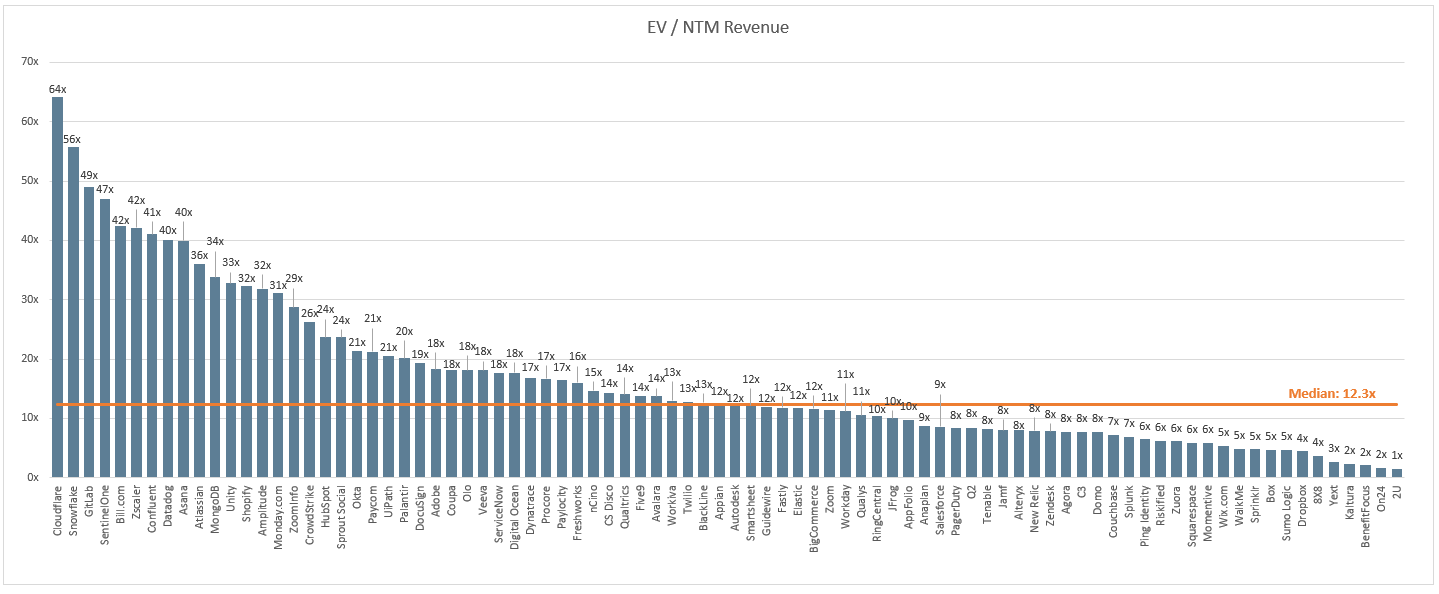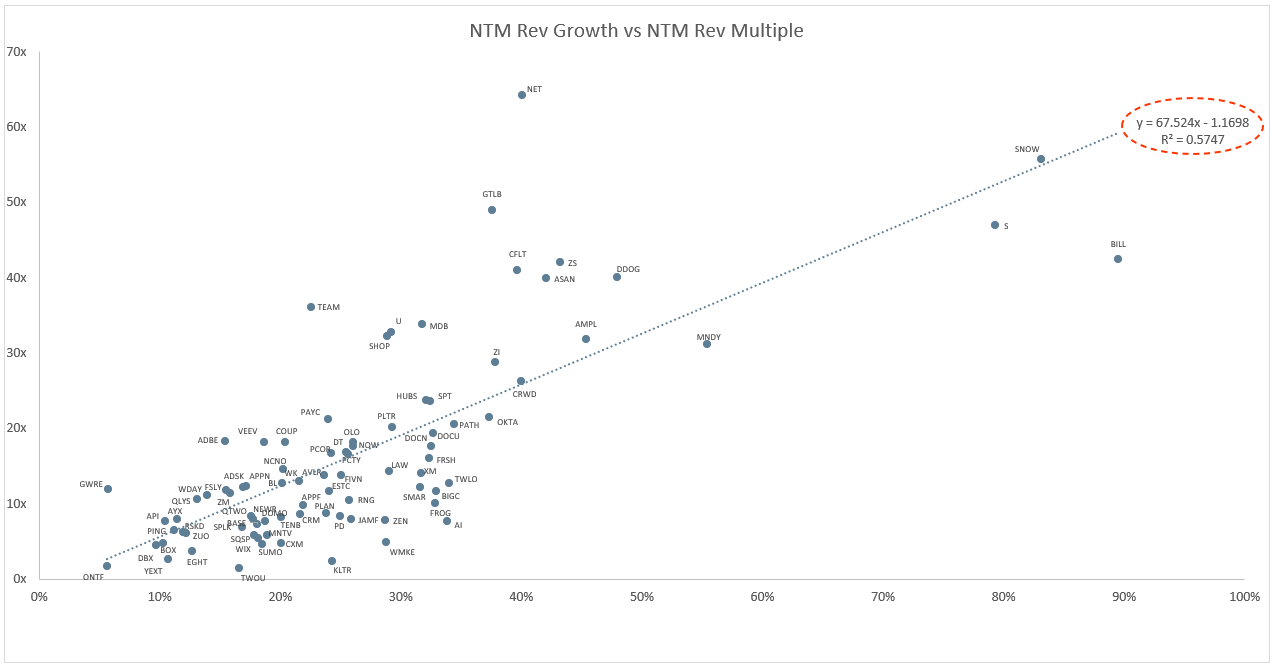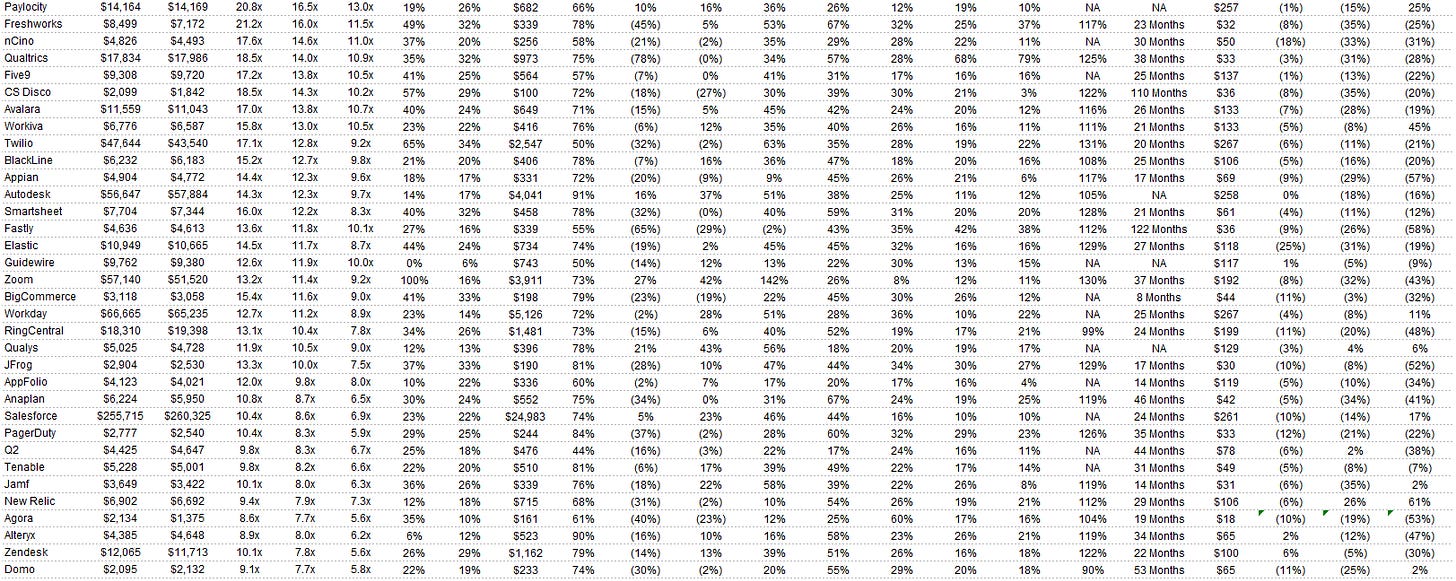Clouded Judgement 12.3.21
Every week I’ll provide updates on the latest trends in cloud software companies. Follow along to stay up to date!
Update on Multiples
This week was quite volatile for cloud software businesses. Only ~10% of the cloud software universe I track ended up with a higher share price this week then one week ago. However, when looking at overall median cloud software multiples - we are still 13% above pre-covid highs, 37% above where we were on Jan 1, 2020, and 11% above the previous peak in August 2019.
Looking at high growth software median only - we are still 86% above pre-covid highs, 119% above where we were on Jan 1, 2020, and 46% above the previous peak in September 2019.
As you’ll see in the graphs below, while the median software company multiple is now well below where we hit in the May lows, for high growth software (companies projected to grow >30% over the next 12 months) the multiples are still ~25% higher than where we were in May ‘21 lows.
This year we’ve really seen software take a hit in all areas except high growth software. The bifurcation between the best software businesses and “the rest” is as large as it’s ever been. As of market close on Thursday, the year to date returns for high, medium and low growth software businesses are as follows:
High Growth: 26%
Mid Growth: (20%)
Low Growth: (23%)
As you can see, high growth software has had a great year! On the other hand, mid and low growth software have gotten punished. Why? The market is putting a premium on growth, and on top of that there’s now a better understanding for which companies have durable growth. Many of the application software companies that saw a huge growth boost from Covid are starting to slow down. On the other hand, many of the infrastructure software companies (Datadog, Snowflake, Confluent, etc) are starting to accelerate
Quarterly Reports Summary
Top 10 EV / NTM Revenue Multiples
Top 10 Weekly Share Price Movement
Update on Multiples
SaaS businesses are valued on a multiple of their revenue - in most cases the projected revenue for the next 12 months. Multiples shown below are calculated by taking the Enterprise Value (market cap + debt - cash) / NTM revenue.
Overall Stats:
Overall Median: 12.3x
Top 5 Median: 49.0x
3 Month Trailing Average: 15.5x
1 Year Trailing Average: 16.0x
Bucketed by Growth. In the buckets below I consider high growth >30% projected NTM growth, mid growth 15%-30% and low growth <15%
High Growth Median: 26.2x
Mid Growth Median: 11.7x
Low Growth Median: 6.2x
Scatter Plot of EV / NTM Rev Multiple vs NTM Rev Growth
How correlated is growth to valuation multiple?
Growth Adjusted EV / NTM Rev
The below chart shows the EV / NTM revenue multiple divided by NTM consensus growth expectations. The goal of this graph is to show how relatively cheap / expensive each stock is relative to their growth expectations
Operating Metrics
Median NTM growth rate: 24%
Median LTM growth rate: 33%
Median Gross Margin: 75%
Median Operating Margin (19%)
Median FCF Margin: 5%
Median Net Retention: 119%
Median CAC Payback: 25 months
Median S&M % Revenue: 44%
Median R&D % Revenue: 26%
Median G&A % Revenue: 19%
Comps Output
Rule of 40 shows LTM growth rate + LTM FCF Margin. FCF calculated as Cash Flow from Operations - Capital Expenditures
GM Adjusted Payback is calculated as: (Previous Q S&M) / (Net New ARR in Q x Gross Margin) x 12 . It shows the number of months it takes for a SaaS business to payback their fully burdened CAC on a gross profit basis. Most public companies don’t report net new ARR, so I’m taking an implied ARR metric (quarterly subscription revenue x 4). Net new ARR is simply the ARR of the current quarter, minus the ARR of the previous quarter. Companies that do not disclose subscription rev have been left out of the analysis and are listed as NA.
This post and the information presented are intended for informational purposes only. The views expressed herein are the author’s alone and do not constitute an offer to sell, or a recommendation to purchase, or a solicitation of an offer to buy, any security, nor a recommendation for any investment product or service. While certain information contained herein has been obtained from sources believed to be reliable, neither the author nor any of his employers or their affiliates have independently verified this information, and its accuracy and completeness cannot be guaranteed. Accordingly, no representation or warranty, express or implied, is made as to, and no reliance should be placed on, the fairness, accuracy, timeliness or completeness of this information. The author and all employers and their affiliated persons assume no liability for this information and no obligation to update the information or analysis contained herein in the future.















